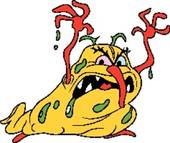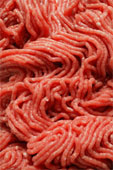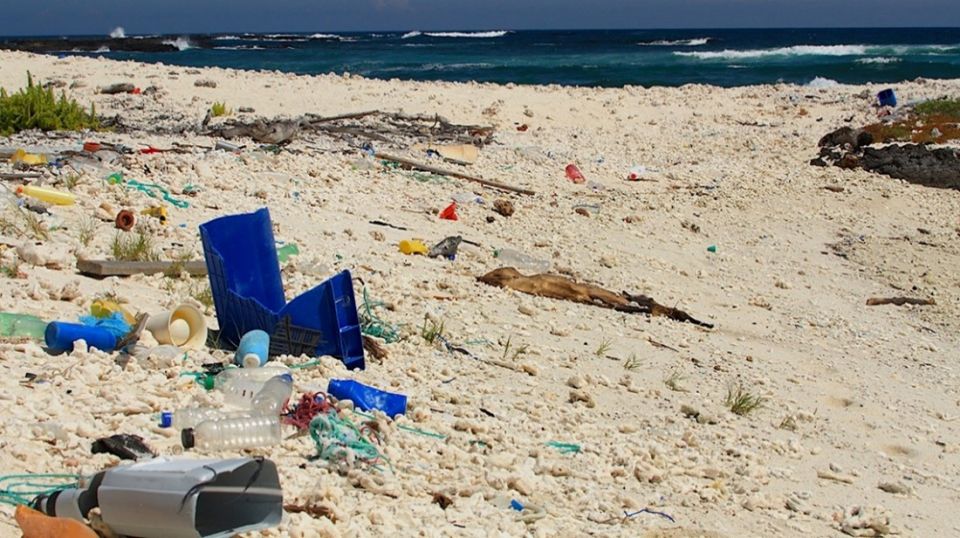Food irradiation, explained
 Let's talk about food irradiation, which has made some in the general public fearful simply because a form of the word "radiation" is involved. Irradiation is used to destroy harmful bacteria and parasites that might be inadvertently present in some food matter. Irradiation makes the food safer for human consumption and, at low levels, it extends food's shelf life and can be used to control insects.
Let's talk about food irradiation, which has made some in the general public fearful simply because a form of the word "radiation" is involved. Irradiation is used to destroy harmful bacteria and parasites that might be inadvertently present in some food matter. Irradiation makes the food safer for human consumption and, at low levels, it extends food's shelf life and can be used to control insects.

E. coli bacteria
Food irradiation starts with basic physics. Ionizing radiation converts an atom or molecule into an ion by adding or removing charged particles such as electrons or other ions. In food irradiation, this ionization process results in the breakdown of the DNA ( deoxyribonucleic acid) of targeted food pathogens, such as the E. coli (Escherichia coli) bacteria.
This DNA breakdown kills the unwanted pathogens and sterilizes the food product.
Food irradiation is 'cold pasteurization'
The food irradiation process uses energy from the wavelength of 10-10 to 10-12 meters on the electromagnetic spectrum, a frequency of 1018 to 1020 and energy levels of up to 10 megaelectronvolts. This amount of energy is so low that it has been called cold pasteurization. When we think of sterilization processes, we think commonly of milk pasteurization, which is a heat process. In heat pasteurization, however, the product is brought up to a temperature of more than 161 °F (72 °C).

Radura symbol
Don't confuse food irradiation with ultra-violet radiation and irradiated milk, which use different processes. All food products treated with ionizing radiation are clearly labeled with the radura, an international symbol that indicates that a food product has been irradiated. The symbol's graphical details and colors vary may vary from country to country.
Food irradiation kills microbes, but does not affect food products
The food product does not change when treated with food irradiation. While heat sterilization damages both the food and the microbe, cold sterilization selectively targets the microbe, or pathogen. Eliminating the offending microbe while preventing any changes to the food composition is a huge benefit to the food industry and to the consumer.
There are three sources of the energy used in food irradiation: beta particles, gamma waves, and x-rays. All three sources have the same effect on the pathogens.
Common uses of food irradiation in the United States
In the United States, food irradiation is used as follows:
- Disinfesting tropical fruit from Hawaii and other tropical agriculture areas (Low dose 0.1 to 1 KiloGray or KGy, a radation unit of measure). Hawaii, like most tropical climates, has vast amounts of agriculture pests. Agricultural interests in the continental United States do not want to risk introducing a pest that would damage domestic agriculture production and the export market so the pest must be eliminated. The only way to get tree-ripened papayas into the continental United States is to treat it with ionizing radiation. Consumers want tasty, tree- ripened fruit from tropical climates, and the average U.S. citizen needs to consume more fresh fruits and vegetable.
 Pasteurizing meats and fish (Moderate dose 1 to 10 KGy). The cooking of meat kills pathogens. When consumers bring uncooked meat into their homes, the pathogens are hitchhikers. Various E. coli outbreaks in beef hamburger and Salmonella from poultry products make news headlines. Using food irradiation to pasteurize meats and fish, however, can help to eliminate these types of outbreaks. The poultry and beef industry have been very frustrated trying to control some bacteria pathogens. Some strains of E. coli bacteria are very pathogenic and of very low doses (i.e., the number of bacteria), which can result in kidney damage, especially in young children. This pathogen is especially troublesome in Canada and Argentina, where the treatment of beef with ionizing radiation has never been approved. Both of these countries rely on aggressive Hazardous Analysis and Critical Control Point (HACCP)-like inspections instead of other intervention technology, such as food irradiation.
Pasteurizing meats and fish (Moderate dose 1 to 10 KGy). The cooking of meat kills pathogens. When consumers bring uncooked meat into their homes, the pathogens are hitchhikers. Various E. coli outbreaks in beef hamburger and Salmonella from poultry products make news headlines. Using food irradiation to pasteurize meats and fish, however, can help to eliminate these types of outbreaks. The poultry and beef industry have been very frustrated trying to control some bacteria pathogens. Some strains of E. coli bacteria are very pathogenic and of very low doses (i.e., the number of bacteria), which can result in kidney damage, especially in young children. This pathogen is especially troublesome in Canada and Argentina, where the treatment of beef with ionizing radiation has never been approved. Both of these countries rely on aggressive Hazardous Analysis and Critical Control Point (HACCP)-like inspections instead of other intervention technology, such as food irradiation.- Eliminating food spoilage to increase shelf life (Higher dose over 10 KGy). Spices and other ingredients are contaminated with many kinds of microbes. Most do not cause a problem unless the right microbe gets into the processed food. Spoilage may result in a shortened shelf life. When ingredients are mixed with the commercially prepared food product, the microbes may grow and result in off flavors. The food becomes unacceptable.
Why should nuclear professionals be interested in food irradiation?
- Healthy habits include eating fresh food, such as tree-ripened fruit. In the United States, more than half of the beef consumed is in the form of hamburger, which can be easily treated with irradiation to kill pathogens.
- American Nuclear Society members should learn about their cousins involved with food irradiation, which is one of those "other" nuclear technologies.
- As nuclear professionals, we must promote nuclear technologies that can help to save lives to a public that is not always comfortable with the technologies. Let's share this information on how to better communicate the benefits of nuclear science.
Did you know? Other types of irradiation
Irradiation has been used to sterilize medical and personal hygiene products for more than 40 years. It is also used in the manufacture of plastic products.
 Irradiation is used to sterilize about 40 percent of the single-use sterile medical devices currently manufactured in the United States, including bandages, blood plasma, burn ointments, catheters, eye ointment, hypodermic syringes, orthopedic implants, intravenous administration sets, surgical drapes, sponges, swabs, surgeons' gloves, procedure packs, trays, and sutures.
Irradiation is used to sterilize about 40 percent of the single-use sterile medical devices currently manufactured in the United States, including bandages, blood plasma, burn ointments, catheters, eye ointment, hypodermic syringes, orthopedic implants, intravenous administration sets, surgical drapes, sponges, swabs, surgeons' gloves, procedure packs, trays, and sutures.
Irradiation is also used for microbial reduction or sterilization of many personal hygiene products, such as aerosol saline solutions, baby bottle nipples, baby powder, bulk cotton bales, contact lens cleaning solutions, cosmetic ingredients, bar and liquid soap, detergents, polishes, shampoos, and hair cream.
Food packaging that often is irradiated to eliminate bacteria includes bulk food containers, cream cups and lids, dairy and juice cartons, plastic roll stock, heat shrinkable film, and laminated foil bags. Irradiation is also used on pet treats and various animal foods, including special diets for laboratory test animals. There are hundreds of other products that are irradiated that are not mentioned above.
For more information
 For more information, please visit the Food Irradiators Processor Alliance's Web site at www.fipa.us. FIPA is the commercial arm of the food irradiation industry. You can follow its links to obtain a vast amount of scientific and technical (S&T) information.
For more information, please visit the Food Irradiators Processor Alliance's Web site at www.fipa.us. FIPA is the commercial arm of the food irradiation industry. You can follow its links to obtain a vast amount of scientific and technical (S&T) information.
Food irradiation S&T has been studied extensive since the 1930s. The U.S. Army led the investigation through the 1960s, and Wikipedia has an excellent overview of food irradiation available here.
ANS offers A Day with the Atom, by Alan Waltar, which is available online. Waltar's column traces the everyday uses of nuclear science and technology.
Bottom Line
Food irradiation can save lives. Why are food irradiation and nuclear technologies not more embraced in the U.S.? What do you think? Please post your comments.
 Joseph Butterweck is an ANS member and the director of Environmental Medicine Services for the Aerospace & Environmental Medicine Group in Fresno, Calif. Dr. Butterweck is a practicing veterinarian and became interested in food irradiation because it is the best option to control our major food pathogens. He was consultant to General Atomics, both the U.S. and Canadian Governments and the private food industry including Merck & Co. His work also included food safety in Argentina and Eastern Europe. He is a contributor to the ANS Nuclear Cafe.
Joseph Butterweck is an ANS member and the director of Environmental Medicine Services for the Aerospace & Environmental Medicine Group in Fresno, Calif. Dr. Butterweck is a practicing veterinarian and became interested in food irradiation because it is the best option to control our major food pathogens. He was consultant to General Atomics, both the U.S. and Canadian Governments and the private food industry including Merck & Co. His work also included food safety in Argentina and Eastern Europe. He is a contributor to the ANS Nuclear Cafe.



